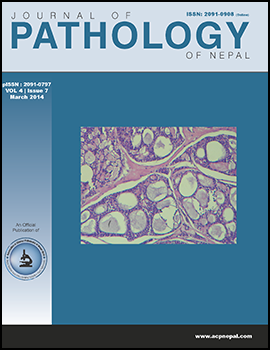Antibiotic susceptibility pattern of staphylococcus aureus and methicillin-resistant staphylococcus aureus in a tertiary care hospital
DOI:
https://doi.org/10.3126/jpn.v4i7.10297Keywords:
Nosocomial infection, MRSA, Staphylococcus aureusAbstract
Background: Methicillin resistant Staphylococcus aureushas emerged as one of the most important nosocomial pathogens. It invokes a tremendous financial burden and enhanced morbidity and mortality due to difficult to treat systemic infections.Aim of this study was to determine antibiotic susceptibility pattern of Staphylococcus aureus and Methicillin resistant Staphylococcus aureus.
Materials and Methods: Different clinical specimens were collected and processed for routine culture and antibiotic sensitivity test by standard microbiology techniques.
Results: Out of 1173 samples received for microbiological examination, 100 were found to be S. aureus with 19% cases were Methicillin resistant Staphylococcus aureus (MRSA). Fourteen MRSA were found from inpatient and 5 were from outpatient. MRSA was found higher in female than male and maximum number (31.5%) was found in age group 0-10 years. Staphylococcus aureus was 100% sensitive to Vancomycin followed by Amikacin (90%), Gentamycin (83%), and tetracycline (81%). On urine isolates Nitrofurantoin(91.6%) was drug of choice. All the isolates were resistant to Penicillin G. In case of Methicillin resistant Staphylococcus aureus showed 100% sensitive to Vancomycin followed by Amikacin (84.2%), Tetracycline (63.1%), Ciprofloxacin (42%) and Gentamycin (36.8%). Among urine isolates Nitrofutantoin showed 87.5% sensitive followed by Norfloxacin (75%).
Conclusion: Methicillin resistant Staphylococcus aureus was found 19% of Staphylococcus aureus isolates. It was most common in females, hospitalized patients and young age group. Vancomycin seems to be drug of choice followed by Amikacin. It would be helpful to formulating and monitoring the antibiotic policy and ensure proper empiric treatment.
DOI: http://dx.doi.org/10.3126/jpn.v4i7.10297
Journal of Pathology of Nepal (2014) Vol. 4, 548-551
Downloads
Downloads
Published
How to Cite
Issue
Section
License
This license enables reusers to distribute, remix, adapt, and build upon the material in any medium or format, so long as attribution is given to the creator. The license allows for commercial use.




